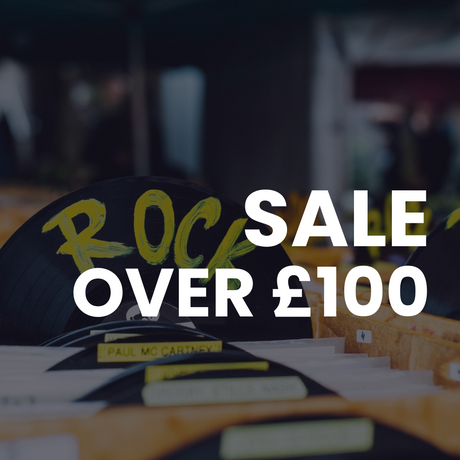The term "bootleg recording" originated from the practice of smuggling illicit alcohol concealed in the leg of a boot during Prohibition in the United States. Similarly, bootleg records were unauthorised recordings of live performances or unreleased studio sessions, often distributed covertly without the artist's consent. This underground phenomenon gained momentum in the mid-20th century with the advent of portable recording devices, allowing fans to capture and share rare music outside official channels.
Welcome to the world of bootleg vinyl! We’ll be exploring the world of bootlegs, sometimes controversial and often valuable - they can provide a window into little-known corners of an artist’s discography.
Contents:
Introduction: Bootlegs vs. Counterfeits
While bootlegs might be unofficial, they aren’t typically intended to deceive or rip off the artist. They are normally made by fans and will contain previously unreleased material or live recordings. A band very famous for its bootleg sharing is Grateful Dead. Fans (Deadheads) have apparently made 14,566 bootleg recordings of the band!
This level of recording and sharing has enabled lots of their shows to be experienced by anyone and to go down in history – here’s a Rolling Stone article providing a rundown of 20 of the greatest shows with links to the recordings.

On the other hand, counterfeit records are created to copy a record that has already been released. This is usually done for records that are particularly sought after or have been out of press for a long time as a means of profiting from the demand.
Several men were jailed in 2018 in the UK for manufacturing and distributing thousands of counterfeit 1960s Northern Soul records, this included artists such as Marvin Gaye and Art Freeman. It took them four years to catch the gang, and some of the records had spelling mistakes and labels that didn’t match.

Counterfeits have been around for as long as recorded music has been around, but the quality of counterfeits has increased hugely since the beginning. The record most widely counterfeited is ‘Introducing the Beatles’. There is a lot of detail around about how to spot a fake copy of this record – If you’re interested here’s one site that goes far into how to spot a counterfeit copy.
Above: an introduction to the real version of Introducing The Beatles.
So, counterfeits and bootlegs aren’t quite the same, but it doesn’t mean people are always happy about bootlegs. Robert Fripp of King Crimson is famous for not being so pleased by fans making and sharing unofficial recordings of his shows.
In many situations or everyday speak, it seems that bootleg is often used interchangeably with counterfeit or fake, so it feels important to note that there is a distinction here and that bootlegs are rarely created with illicit intentions.
Read on to go deeper into a variety of records and ideas that go against standard record pressing conventions.
The type of bootleg we're most fascinated by: Music on Ribs
Images in this section are from the Bone Music website (X Ray Audio)
One of the most fascinating types of bootlegs (well they are probably technically counterfeits...) we’ve discovered in our research has got to be rib records or ‘music on ribs’. So much so that we’ve had this on the list for ages and have finally found the perfect opportunity to write about it.
 |
 |
Rib records originate from the Soviet Union in the 50s and 60s when many types of music were banned from broadcast. They are music pressed onto X-rays bought or taken from the bins in hospitals. Hospitals were required to dispose of x-rays after a year because they were considered a fire risk – this lead to a consistent supply.
The pressings were of such poor quality that they could be played only 5 to 10 times and spin at 78rpm – the centre hole was typically burned into the disc using a cigarette.
There was a black market for real copies of banned records, but these were extremely sought after and became extremely rare and valuable. So, a need for cheaper alternatives arises – and so ribs records were born. It was necessary to print on x-rays because the state controlled all the means of manufacturing music and raw material supply.
A law was passed in 1958 to ban the home production of recordings, but with the music still being banned by the Soviet leaders, production of bone music was bound to continue.
Click the picture below to go to a page containing some bone music recordings. They include tracks by artists like Elvis Presley. You’ll be pleased to know that records of this condition wouldn’t get though our grading process (unless they were a genuine rib record that is)...
The above recordings were compiled by the X-Ray Audio project which was started nearly ten years ago by Stephen Coates. He was on tour in Russia with his band when he came across a record pressed on an x-ray at a market stall. The people around him thought little of it, but he brought it home to England and studied it further.
That discovery has blossomed into a fascinating project working to educate and preserve these little pieces of history. They’ve had an ‘x-hibition’ on tour in various places around the world – the next location is set to be Bradford in 2024. You can find out a lot more on their site.
But just how popular and professional can a bootleg record be?
From Bob Dylan's 1969 'Great White Wonder' to Prince's 'Black Album' there's an awful lot of them out there.
There are quite a number of books and websites dedicated to documenting bootlegs through history, including 'The Bootleg Guide' by Garry Freeman and Hot Wacks, a magazine from Canada, which we have a look at at the end of this post. Bootlegs are typically recognised as being poorly recorded or manufactured, but this literature attempts to review and advise on what is the best content out there.
The Bootleg Guide seems pretty rare though - a copy from Waterstones could set you back £129...
With the advent of online file sharing, the accessibility of unofficial recordings has changed significantly, with almost anything being available on YouTube in some form. However, there is still a market for original physical bootlegs, much like there is for ordinary records.
Many labels have now learnt to capitalise on the unreleased market by releasing official collections of their artists back catalogue of studio sessions and live shows.
Here are some of the most popular bootlegs through history...
Click the images to listen to a track or sample from each bootleg.
Great White Wonder - Bob Dylan, July 1969
The most iconic of bootlegs, it was originally made with a plain white gatefold sleeve which lead to it gaining the name 'Great White Wonder' - hence, later copies have this title stamped on.
Image source
The Dark Side of the Moo - Pink Floyd, 1967-71
This bootleg was created in order to compile a collection of tracks that were difficult to find in the US market. To avoid detection, the bootlegger (known as 'Richard') used the name 'The Screaming Abdabs' on the label - it was an early name used by Pink Floyd.
Image source
Mystery Box - Frank Zappa, 1986
This bootleg consists of ten LPs of material! However, Zappa was never a fan of bootlegs and so fought back at the bootleggers by releasing his own version of this record called 'Beat the Boots' in 1991. The recordings span fifteen years, from 1967 to 1982.
Image source
The Black Album - Prince, 1987
This was supposed to be released officially, but Prince decided to pull it a month before release because he believed it was 'evil'... However, some promo copies had already been sent out and so bootlegs were made and sold. Warner eventually released it officially in 1994, but the bootlegs remain far more valuable.
There's so many more than just those four out there. If you’re looking for some interesting listening, check out the history of bootlegs below as told by David Hepworth on BBC Radio 4.
Are there any artists who are completely happy with bootlegging?
It’s time for something a bit different and a lot more modern than we’ve discussed so far. We’re going to be looking at an album released in 2017 by Australian Progressive/Psychedelic Rock band King Gizzard and the Lizard Wizard (or just King Gizzard for short) The record is called Polygondwanaland and was released under an open-source license.
This means that all the master tapes and files were uploaded to the bands website free for anyone to use for any means. Through this, the band was encouraging their fan base to create their own versions of the record. They even said “Ever wanted to start your own record label? GO for it! Employ your mates, press wax, pack boxes. We do not own this record. You do. Go forth, share, enjoy.”

The record was fourth out of five albums released by the band in 2017 – they consistently seek ways to create work in new forms. From playing with microtones from non-western scales (video below explaining that...) to exploring no less than nine genres through their music including doom metal and garage rock.
By allowing fans to press their own copies of the record, they have ended up with at least 323 Discogs versions of the album. This is in comparison to an average of 15-25 on all their other releases...
Here’s a few of the most interesting fan made releases we could find, the versions span floppy discs, 8-Track Cartridge, reel to reel audio tape and 10” shaped vinyl picture discs.
1. An edition of 20 hand numbered 8-Tracks.
This has sold for £81!

The same fans also made a floppy disc version which includes a Frogger (the 1981 arcade game where you play a frog who has to cross a road) inspired video game, but with a King Gizzard twist.
2. Various Coloured Versions by Salty Dog
This one was released by 'Salty Dog' a 'One man record label based in Melbourne, Australia.' Salty Dog created several very limited versions of the record, all in different colours. This one has a bright green and pink vinyl.

|
 |
It includes a different colour artwork design by Eduardo da Floresta, a graphic designer from Portugal.
3. Lathe Cut Edition, 33 copies
Only 33 of these were made by 3.45RPM who are based in the UK. They specialise in lathe cut records - essentially meaning every record is the 'master' cut, rather than being stamped into plastic.

They used a vintage wallpaper for the sleeves and it has only sold once, for £100...
4. Lathe Cut X-Ray
And finally, following on from our look into Bone Music above, this version was lathe-cut onto an X-Ray!

It was made in Finland and there are only five of them in existence, and a copy has never sold on Discogs. At the time of writing, there is one up for sale for £440.
So, people must have collected bootlegs. Is there anything that helped or helps to document what was being released?
They did indeed. Introducing Hot Wacks Magazine – published out of Ontario, Canada by Kurt Glemser. It is commonly seen as the standard reference source for bootlegs published from the late 70s, having been first published in 1977. It has often been referred to as ‘The Bootleg Bible’ and was apparently officially published in the UK under that name. It started life in 1977 as a 200-page book, documenting all the main bootleg labels – depending on labels and fans to share bootlegs that they felt were relevant enough for inclusion.
After this initial book, they released some revised editions – going up to over 800 pages! They then went on to create a quarterly magazine which ran from 1979 to 1984. This quarterly magazine followed the well established sales tactics of the likes of Top of the Pops vinyl compilations and the Instagram algorithm...

|
 |
Through the 90s they continued with some supplemental books, now edited by Bob Walker. Since 2003, the magazine has been published for free online – their website is still running, though most new reviews posted are of CD bootlegs.
The creator of Hot Wacks, Kurt Glemser, was seen as being quite central to the North American bootleg operation, especially by the FBI. However, while he was involved in the manufacture of some bootlegs, he was mostly responsible for the compilation of information and so the authorities could do little to him. A bootleg Kurt was responsible for was a collection of Led Zeppelin live recordings, released in 1976 under the label name ‘K & S Records’.

|
 |
The pictures above show two covers from the earlier book versions of Hot Wacks. On the left is the 5th edition, and on the right is the eventual standard design featuring many album covers. You can find limited copies of it here.
There was a similar magazine published in Japan called Gold Wax, which came about in 1989. It started out being more generally about music – including a Frank Zappa interview translated from Goldmine magazine – but by the fifth issue it was mostly about bootleg CDs, and much like the physical editions of Hot Wacks it lasted until 2003.

|
 |










